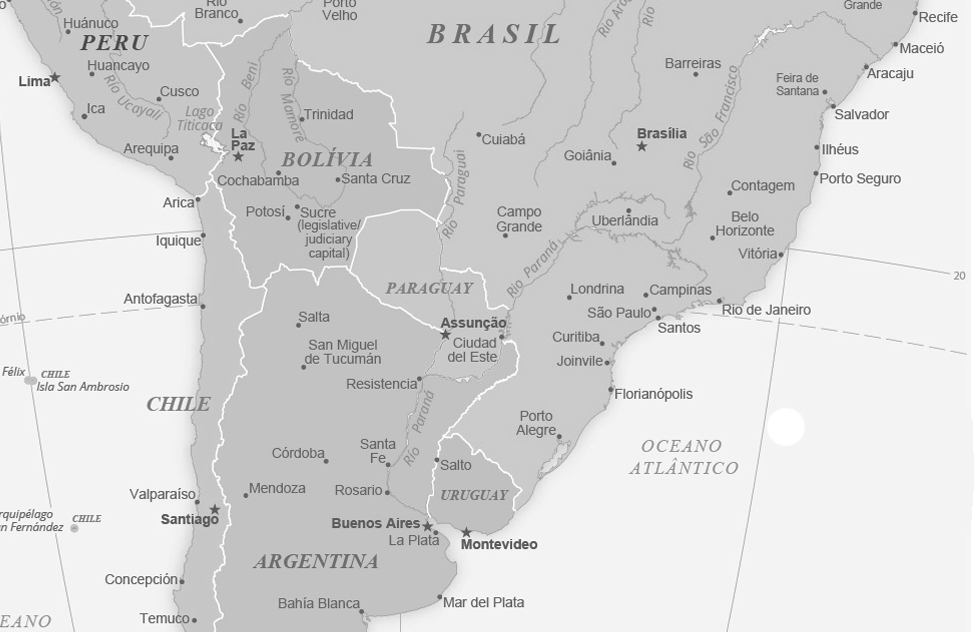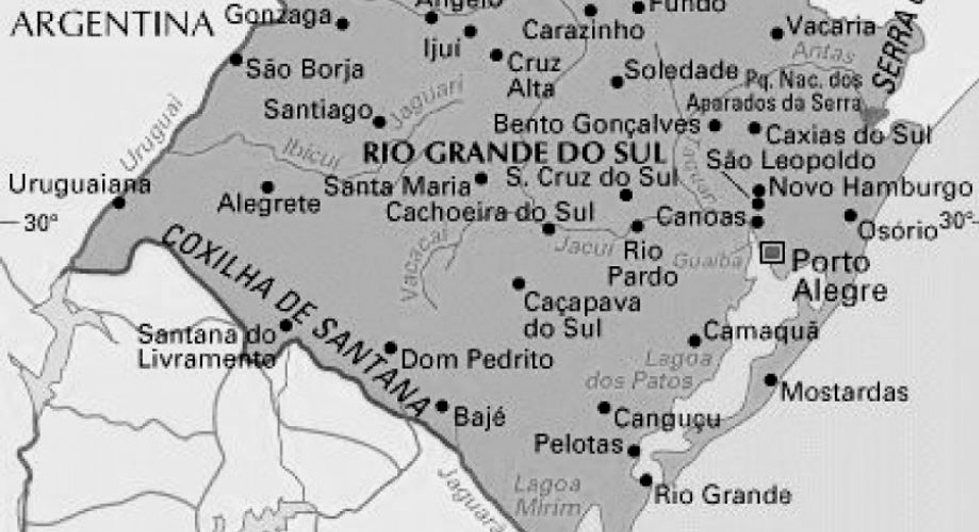STen Fábio César Santos de Assunção
The Military Aviation School, created in 1919, was the first Aviation Unit of the Brazilian Army. In its facilities, located in Campo dos Afonsos, in Rio de Janeiro, then the federal capital and the main region to be militarily defended, the foundations for the beginning of the development of an aviation culture were established, under French technical influence.
Despite the concerns with the protection of the federal capital, the southern borders of Brazil, especially those with Argentina, were the places that aroused great concern at the time. Studies indicated that an invasion attack could come from there.
In that historical period, long overdue in Brazilian strategic analysis, Argentina was always considered a potential invader in the event of war. There was speculation about a possible mobilization of its troops on the border with Rio Grande do Sul. From Corrientes, the Argentines could launch attacks on the cities of Uruguaiana, Itaqui and São Borja. Argentine studies also showed concerns about Brazil.
A defense plan against the supposed invaders should foresee the protection of Santa Maria, an important railroad junction through which army reinforcements would move, as well as the cities where the hypothetical attack would come, such as Uruguaiana, Itaqui, and São Borja.
In 1922, the year in which Brazil’s attention was focused on the celebrations of its first centennial of independence, the Brazilian Army, concerned with the fragility of the country’s borders, took several measures that increased not only its capacity for action but also its deterrence capacity.
One of these measures came through Decree no. 15.235, of December 31, 1921, which was published on February 2, 1922. In this Decree, the first step in the plans for the deployment of Military Aviation outside Rio de Janeiro, it was foreseen the creation of 12 aviation squadrons that would be distributed throughout the states of Rio Grande do Sul, São Paulo, Rio de Janeiro, Minas Gerais, Santa Catarina, and today Mato Grosso do Sul.
The first region chosen to receive this air support was precisely the extreme south of the country. On December 31, 1921, when Decree No. 15.235 was issued, two train sets left Rio de Janeiro for Santa Maria, carrying aeronautical material for the implementation of the new aviation fields.


On January 7, 1922, a train headed by Captain Alzir Mendes Rodrigues Lima arrived in Santa Maria, bringing French mechanics, 50 squares, airplanes and several machines for the workshops. Its mission was to prepare the installations for three squadrons and an aviation park.
In practice, the distribution of the squadrons was slightly different from what was foreseen in Decree No. 15,235. Santa Maria received an aviation park, a fighter squadron and a bombing squadron, and Alegrete received an observation squadron. Thus the cities of Uruguaiana, Itaqui and São Borja were less than 130km from Alegrete’s air support, and the important railroad junction would be supported by air support from Santa Maria.
Although the park’s large and modern facilities were inaugurated on April 2, 1922, the act that marks the creation of the Aviation Squadrons Group of Rio Grande do Sul happened through an Ordinance from the Minister of War on June 5, 1922. This Ordinance, published in Army Bulletin #26, of June 10, 1922, created an Aviation Squadron Group in the 3rd Military Region, directly subordinated to the Military Region Commander for matters of discipline, administration and tactical instruction; and to the Army General Staff for technical instruction and general inspection.
The Aviation Squadron Group of Rio Grande do Sul was the embryo, within the aeronautical sector, of an audacious restructuring project of the Brazilian Army, which sought to correct vulnerabilities related to the security of our borders in the beginning of the last century. The contemplation of Rio Grande do Sul with the immediate deployment of a Squadron Group confirms the specific well-founded fear regarding the possibility of an Argentine invasion.
In 1921, according to the initial planning, the Rio Grande do Sul Aviation Squadron Group would receive 45 aircraft: 15 fighter, 15 observation, and 15 bombing. In 1922, nine fighter aircraft (Spad VII), four observation aircraft (Breguet XIV), and six bombing aircraft (Breguet XIV) entered into operation.
At its peak, it owned as many as 30 aircraft. By the end of 1926, only four Breguet XIV aircraft were still in operation: the São Borja, the Uruguayana, the Itaquy and the Livramento, all belonging to the Alegrete squadron. In a short period of time, the promising facilities in Santa Maria were transformed into an airplane graveyard.
Although the park’s large and modern facilities were inaugurated on April 2, 1922, the act that marks the creation of the Aviation Squadrons Group of Rio Grande do Sul happened through an Ordinance from the Minister of War on June 5, 1922. This Ordinance, published in Army Bulletin #26, of June 10, 1922, created an Aviation Squadron Group in the 3rd Military Region, directly subordinated to the Military Region Commander for matters of discipline, administration and tactical instruction; and to the Army General Staff for technical instruction and general inspection.
The Aviation Squadron Group of Rio Grande do Sul was the embryo, within the aeronautical sector, of an audacious restructuring project of the Brazilian Army, which sought to correct vulnerabilities related to the security of our borders in the beginning of the last century. The contemplation of Rio Grande do Sul with the immediate deployment of a Squadron Group confirms the specific well-founded fear regarding the possibility of an Argentine invasion.
In 1921, according to the initial planning, the Rio Grande do Sul Aviation Squadron Group would receive 45 aircraft: 15 fighter, 15 observation, and 15 bombing. In 1922, nine fighter aircraft (Spad VII), four observation aircraft (Breguet XIV), and six bombing aircraft (Breguet XIV) entered into operation. At its peak, it owned as many as 30 aircraft. By the end of 1926, only four Breguet XIV aircraft were still in operation: the São Borja, the Uruguayana, the Itaquy and the Livramento, all belonging to the Alegrete squadron. In a short period of time, the promising facilities in Santa Maria were transformed into an airplane graveyard.

On March 12, 1928, after a little more than five years of creation, the Rio Grande do Sul Aviation Squadron Group was dissolved. Its ephemeral existence and consequent extinction was caused by the events of the troubled decade of the 1920s, when the Tenentist Rebellions clashed with the government system in force. This, in turn, distrustful of the danger that airplanes represented to the maintenance of its interests, imposed measures that negatively impacted the development of aviation and led to the inoperability of the Army’s air fleet.
In 2022, the year in which Brazil’s attentions are turned to the celebration of its bicentennial of independence, we cannot miss the centennial of the creation of the Aviation Squadrons Group of Rio Grande do Sul and remember the achievements and the contributions of the Army Aviation for the defense of our territory and the aeronautical development of the country.
About the author:
Fábio César Santos de Assunção is a sub-lieutenant in the Brazilian Army, coming from the class of 1996, of the Training Course for Sergeants in Communications Maintenance – School of Communications. He has completed the Advanced Commutation Course – School of Communications (2009) and the Basic Army Aviation Maintenance Course – Army Aviation Instruction Center (2013).
He has a degree in Physics from Universidade Estadual Paulista (2002) and in History from Universidade de Taubaté (2021). He was a monitor at the Army Aviation Instruction Center (2010-2012 and 2015-2017) and a flight mechanic for the HA-1 (Esquilo) aircraft. He currently serves as Historian of the Army Aviation Cultural Space.
Cover photo – caption: 3rd Observation Squadron in Santa Maria – RS, 1922 – Photos: Rudnei Dias da Cunha’s personal archive
*** Translated by the DEFCONPress Team ***
